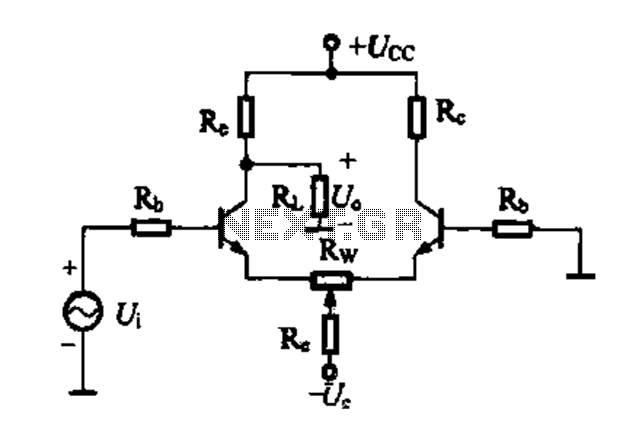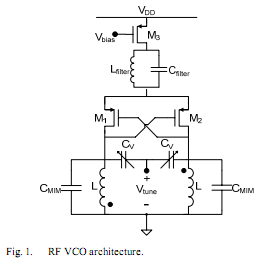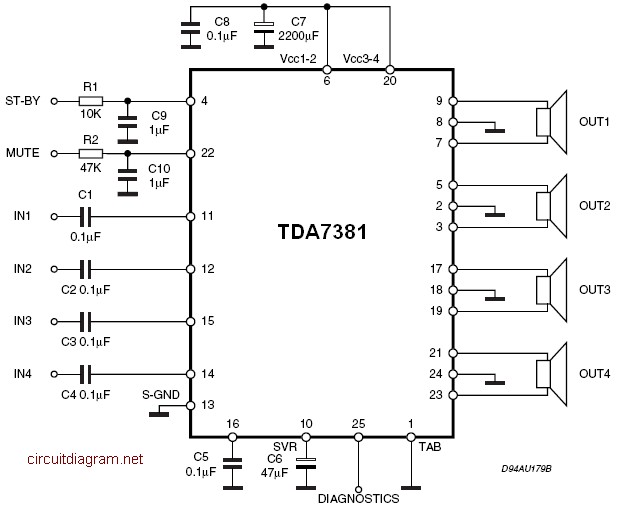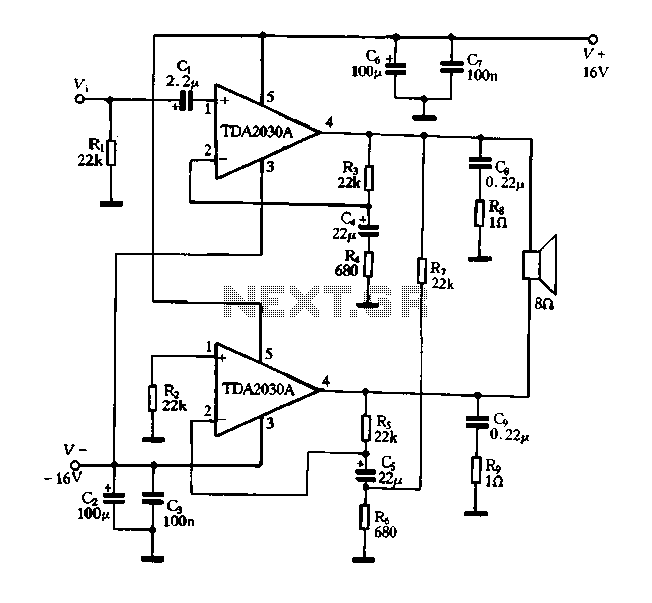
APH-1050 Power Amplifier
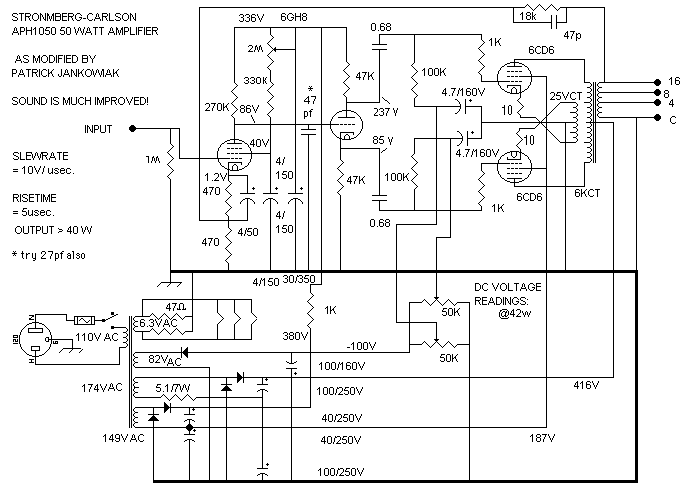
If 40 watts RMS from 20Hz to 30KHz +/-1.5 dB is appealing, this experiment may be of interest. A significant issue with public address equipment is the use of audio output transformers that lack sufficient iron to manage lower frequency content at the amplifier's full rated power. It is advisable to select amplifiers where the output transformer is comparable in size to the power transformer; larger is preferable. Another concern with output transformers is the thickness of the laminations, with thinner laminations being more desirable than fewer thicker ones. The laminations should be significantly thinner than those of the power transformer. If the transformer features a 25V balanced line output winding, it can be utilized to supply power feedback to the cathodes of the output tubes, addressing multiple issues. While it is important to be discerning, it is also necessary to remember that these are PA amplifiers. A pair should be sought for stereo applications. The output transformer should ideally be larger than the power transformer and also include a 70/25V center-tapped line winding in addition to the 4/8/16-ohm speaker winding. Modifications may involve different tube types, power supply voltages, and biasing/balancing configurations. The Stromberg-Carlson APH-1050 can accommodate many of these changes and will be discussed specifically. Feedback from a discerning music enthusiast regarding four modified amplifiers is noteworthy: "The amps are the best electronics purchase I've ever made. They are absolutely reliable, do not overheat, require low maintenance, have inexpensive replacement tubes (which I haven’t needed yet), and produce clean, quiet sound with good bass response. They pair well with AR3a speakers, which provide good bass at a low cost. The amps must be high current, as that is what everyone says works best with AR3a speakers." It is important to note that for models other than the specific one described, slightly different strategies may be necessary to achieve optimal sound, but the underlying principles remain consistent and valid. The stock APH-1050 utilizes a 7199 as a preamp/phase inverter and 7581 output tubes, both of which have become costly. A supply of 100 new 6GH8A tubes and approximately 20 new 6CD6G tubes was available, prompting their use since the amplifier was devoid of tubes. Specifications indicate that the 6GH8A, which was frequently employed as a 3.58 MHz amplifier in color television sets, is suitable for the driver. Sound Valves employs the 6GH8A in their $899 VTA70B/K 35/35W stereo tube amp kit, and customer feedback has been positive. The 6CD6 beam power tubes are more robust than the original 7581 tubes, rated for 200 milliamperes plate current, surpassing the 74mA rating of the 7581 and the 175mA of the 6550. The 6CD6 requires 2.5 amperes for its 6.3V heater, raising concerns since the 7581 only requires 0.9 amperes. This aspect must be carefully considered when changing tube types. Extended operation of the transformer under this increased load did not result in excessive heating of the windings. If there are any uncertainties, retaining the original tubes or installing a separate heater-supply transformer is advisable. The 6CD6 operates at relatively low screen voltages, only 180V compared to the 350V required for the 7581, necessitating that the G2 voltage be sourced from the center of the driver's voltage.
The design of an audio amplifier that operates efficiently across the specified frequency range of 20Hz to 30kHz at 40 watts RMS necessitates careful consideration of the output transformer. The output transformer must be adequately sized to ensure it can handle the full power output without distortion, particularly in the lower frequency range. The choice of laminations plays a critical role in the efficiency and performance of the transformer, as thinner laminations reduce eddy current losses, allowing for better frequency response and power handling capabilities.
In the context of the Stromberg-Carlson APH-1050, modifications to the amplifier can enhance its performance. The substitution of the original 7581 tubes with the 6CD6 tubes allows for greater current handling, which is advantageous for driving speakers that require higher power. Additionally, the use of the 6GH8A as a driver tube can provide improved performance characteristics due to its design for high-frequency applications.
The output stage configuration should be carefully evaluated to ensure proper biasing and balancing, which is essential for maintaining sound quality and reliability. Implementing feedback from the output transformer to the cathodes can mitigate various issues, including distortion and thermal runaway, ensuring stable operation across different load conditions.
When modifying the amplifier, attention must be paid to the power supply design, particularly the heater supply for the tubes. The increased current demand of the 6CD6 tubes necessitates a thorough analysis of the existing power supply capabilities. If the existing transformer cannot accommodate the additional load without overheating, a dedicated heater supply transformer may be required.
In conclusion, achieving optimal performance from the APH-1050 or similar amplifiers involves a comprehensive understanding of the components and their interactions. The principles discussed are applicable across various amplifier designs, emphasizing the importance of transformer selection, tube compatibility, and power supply considerations in the pursuit of high-fidelity audio reproduction.If 40 watts RMS from 20Hz to 30KHz +/-1. 5 db sounds good to you, then you might enjoy this experiment. The most significant problem with public address gear is the use of audio output transformers which do not have enough iron in them to handle the lower frequency content at the amplifier`s full rated power. Look for amplifiers in which the output transformer is as large as the power transformer. The bigger the better! Another problem with the output transformers is that the laminations are often fairly thick. Many thin laminations are preferrable to fewer thick ones. The laminations should be much thinner than those of the power transformer. If the transformer has a 25V balanced line output winding, then it can then be used to provide power feedback to the cathodes of the output tubes, which will abate a multitude of evils. Don`t be too picky, remember, these are PA amplifiers! Just try to find a pair if you want stereo. The output transformer is actually larger than the power transformer, and the output transformer also has a 70&25V.
C. T. "line" winding as well as the 4/8/16 ohm "speaker" winding. Changes to be made can include different tube types, power supply voltages, and biasing/balancing arrangements. Since the Stromberg-Carlson APH-1050 can use most of these changes, It will be specifically discussed.
In case you may have doubts, see what one very discerning music lover had to say about the four of these amps I modified specially for him, according to this exact Article. "The amps are the best electonics purchase I`ve ever made. They are absolutely reliable, do not get too hot, are low maintenance, have cheap replacement tubes (which I haven`t needed yet), and sound clean and quiet, with good bottom to the sound.
They are a very good match for ar3a speakers, which provide good bass at low cost. The amps must be high current, as that is what everyone says works best with ar3a speakers. " Please keep in mind that in cases other than the exact model I describe, slightly different strategies may apply on the road to good sound, but in any case the principles are identical and "sound". The stock APH-1050 uses a 7199 as a preamp/phase inverter, and 7581 outputs. Both of these fine tubes are now expensive. I happened to have a carton of 100 new 6GH8A tubes, and about 20 new 6CD6G tubes. I decided to use those, since the amplifier came with no tubes and those new tubes were on hand. A check of the tube specifications shows that the 6GH8A, which was commonly used as a 3. 58 MHz amplifier in color TV sets, would be ok for the driver. A precedent to this use would be that Sound Valves uses the 6GH8A in their excellent $899 VTA70B/K 35/35W (BLACK) stereo tube amp KIT amplifier and no one seems to be complaining.
The 6CD6 horizontal-output-type beam power tubes are certainly more robust than the original 7581`s, in fact, they are rated at 200 milliamperes plate current which is far more than the 7581`s 74ma, and even beats the 6550`s 175ma. The 6CD6 uses 2. 5 amperes for its 6. 3V heater, and this was a concern since the 7581 uses only 0. 9 ampere. This is an important concern, and must always be investigated when changing tube types. Extended operation of the transformer with this larger load did not produce any undue heating of the windings.
If in doubt, there is nothing wrong with keeping the original tubes or installing a separate heater-supply transformer. The 6CD6 uses relatively low screen voltages, only 180V as compared to 350V for the 7581, so I took the G2 voltage from the center of the driver`s voltage do
🔗 External reference
The design of an audio amplifier that operates efficiently across the specified frequency range of 20Hz to 30kHz at 40 watts RMS necessitates careful consideration of the output transformer. The output transformer must be adequately sized to ensure it can handle the full power output without distortion, particularly in the lower frequency range. The choice of laminations plays a critical role in the efficiency and performance of the transformer, as thinner laminations reduce eddy current losses, allowing for better frequency response and power handling capabilities.
In the context of the Stromberg-Carlson APH-1050, modifications to the amplifier can enhance its performance. The substitution of the original 7581 tubes with the 6CD6 tubes allows for greater current handling, which is advantageous for driving speakers that require higher power. Additionally, the use of the 6GH8A as a driver tube can provide improved performance characteristics due to its design for high-frequency applications.
The output stage configuration should be carefully evaluated to ensure proper biasing and balancing, which is essential for maintaining sound quality and reliability. Implementing feedback from the output transformer to the cathodes can mitigate various issues, including distortion and thermal runaway, ensuring stable operation across different load conditions.
When modifying the amplifier, attention must be paid to the power supply design, particularly the heater supply for the tubes. The increased current demand of the 6CD6 tubes necessitates a thorough analysis of the existing power supply capabilities. If the existing transformer cannot accommodate the additional load without overheating, a dedicated heater supply transformer may be required.
In conclusion, achieving optimal performance from the APH-1050 or similar amplifiers involves a comprehensive understanding of the components and their interactions. The principles discussed are applicable across various amplifier designs, emphasizing the importance of transformer selection, tube compatibility, and power supply considerations in the pursuit of high-fidelity audio reproduction.If 40 watts RMS from 20Hz to 30KHz +/-1. 5 db sounds good to you, then you might enjoy this experiment. The most significant problem with public address gear is the use of audio output transformers which do not have enough iron in them to handle the lower frequency content at the amplifier`s full rated power. Look for amplifiers in which the output transformer is as large as the power transformer. The bigger the better! Another problem with the output transformers is that the laminations are often fairly thick. Many thin laminations are preferrable to fewer thick ones. The laminations should be much thinner than those of the power transformer. If the transformer has a 25V balanced line output winding, then it can then be used to provide power feedback to the cathodes of the output tubes, which will abate a multitude of evils. Don`t be too picky, remember, these are PA amplifiers! Just try to find a pair if you want stereo. The output transformer is actually larger than the power transformer, and the output transformer also has a 70&25V.
C. T. "line" winding as well as the 4/8/16 ohm "speaker" winding. Changes to be made can include different tube types, power supply voltages, and biasing/balancing arrangements. Since the Stromberg-Carlson APH-1050 can use most of these changes, It will be specifically discussed.
In case you may have doubts, see what one very discerning music lover had to say about the four of these amps I modified specially for him, according to this exact Article. "The amps are the best electonics purchase I`ve ever made. They are absolutely reliable, do not get too hot, are low maintenance, have cheap replacement tubes (which I haven`t needed yet), and sound clean and quiet, with good bottom to the sound.
They are a very good match for ar3a speakers, which provide good bass at low cost. The amps must be high current, as that is what everyone says works best with ar3a speakers. " Please keep in mind that in cases other than the exact model I describe, slightly different strategies may apply on the road to good sound, but in any case the principles are identical and "sound". The stock APH-1050 uses a 7199 as a preamp/phase inverter, and 7581 outputs. Both of these fine tubes are now expensive. I happened to have a carton of 100 new 6GH8A tubes, and about 20 new 6CD6G tubes. I decided to use those, since the amplifier came with no tubes and those new tubes were on hand. A check of the tube specifications shows that the 6GH8A, which was commonly used as a 3. 58 MHz amplifier in color TV sets, would be ok for the driver. A precedent to this use would be that Sound Valves uses the 6GH8A in their excellent $899 VTA70B/K 35/35W (BLACK) stereo tube amp KIT amplifier and no one seems to be complaining.
The 6CD6 horizontal-output-type beam power tubes are certainly more robust than the original 7581`s, in fact, they are rated at 200 milliamperes plate current which is far more than the 7581`s 74ma, and even beats the 6550`s 175ma. The 6CD6 uses 2. 5 amperes for its 6. 3V heater, and this was a concern since the 7581 uses only 0. 9 ampere. This is an important concern, and must always be investigated when changing tube types. Extended operation of the transformer with this larger load did not produce any undue heating of the windings.
If in doubt, there is nothing wrong with keeping the original tubes or installing a separate heater-supply transformer. The 6CD6 uses relatively low screen voltages, only 180V as compared to 350V for the 7581, so I took the G2 voltage from the center of the driver`s voltage do
🔗 External reference

